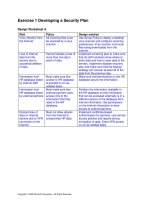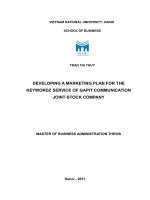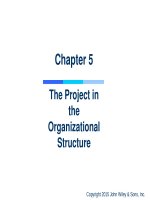Chapter 5 developing a project plan
Bạn đang xem bản rút gọn của tài liệu. Xem và tải ngay bản đầy đủ của tài liệu tại đây (4.82 MB, 50 trang )
Source: Mc Graw Hill Education. All Rights Reserved, 2021
CHAPTER 5:
DEVELOPING THE PROJECT PLAN
© 2021 McGraw-Hill Education. All rights reserved. Authorized only for instructor use in the classroom.
No reproduction or further distribution permitted without the prior written consent of McGraw-Hill Education.
2
Developing the Project Plan
• The Project Network
– A flow chart that graphically depicts the sequence,
interdependencies, & start and finish times of the project
job plan of activities that is the critical path through the
network.
• Provides the basis for scheduling labor & equipment.
• Enhances communication among project participants.
• Provides an estimate of the project’s duration.
• Provides a basis for budgeting cash flow.
• Identifies activities that are critical.
• Highlights activities that are “critical” & can not be delayed.
• Help managers get & stay on plan.
3
From Work Package to Network
WBS/Work Packages to Network
FIGURE 6.1
4
From Work Package to Network (cont’d)
WBS/Work Packages to Network (cont’d)
FIGURE 6.1 (cont’d)
5
Constructing a Project Network
• Terminology
–Activity: an element of the project
that requires time.
A
–Merge Activity: an activity that has
two or more preceding activities on
which it depends (D activity).
B
–Parallel (Concurrent) Activities:
Activities that can occur
independently and, if desired, not at
the same time.
D
C
6
Constructing a Project Network (cont’d)
• Terminology
– Path: a sequence of connected, dependent activities.
– Critical path: the longest path through the activity
network that allows for the completion of all project-related
activities; # the shortest expected time in which the entire
project can be completed. Delays on the critical path will
delay completion of the entire project.
C
A
B
D
(Assumes that minimum of A + B > minimum of C in length of times to complete activities.)
7
Constructing a Project Network (cont’d)
• Terminology
–Event: a point in time when an activity is started or
completed. It does not consume time.
–Burst Activity: an activity that has more than one
activity immediately following it (more than one
dependency arrow flowing from it) (A activity).
B
• Two Approaches
– Activity-on-Node (AON)
A
C
• Uses a node to depict an activity.
– Activity-on-Arrow (AOA)
• Uses an arrow to depict an activity.
D
8
Basic Rules to Follow in Developing
Project Networks
• Networks typically flow from left to right.
• An activity cannot begin until all of its activities are completed.
• Arrows indicate precedence & flow & can cross over each
other.
• Identify each activity with a unique number; this number must
be greater than its predecessors.
• Looping is not allowed.
• Conditional statements are not allowed.
• Use common start & stop nodes.
9
Activity-on-Node Fundamentals
FIGURE 6.2
10
Activity-on-Node Fundamentals (cont’d)
FIGURE 6.2 (cont’d)
11
Network Information
TABLE 6.1
12
Koll Business Center—Partial Network
FIGURE 6.3
13
Koll Business Center—Complete Network
FIGURE 6.4
14
Network Computation Process
• Forward Pass—Earliest Times
–How soon can the activity start? (Early Start — ES)
–How soon can the activity finish? (Early Finish — EF)
–How soon can the project finish? (Expected Time — ET)
• Backward Pass—Latest Times
–How late can the activity start? (Late Start — LS)
–How late can the activity finish? (Late Finish — LF)
–Which activities represent the critical path?
–How long can it be delayed? (slack or float — SL)
15
Network Information
TABLE 6.2
16
Activity-on-Node Network
FIGURE 6.5
17
Activity-on-Node Network Forward Pass
FIGURE 6.6
18
Forward Pass Computation
• Add activity times along each path in the network
(ES + Duration = EF).
• Carry the early finish (EF) to the next activity where
it becomes its early start (ES) unless…
• The next succeeding activity is a merge activity, in
which case the largest EF of all preceding activities
is selected.
19
Activity-on-Node Network Backward Pass
FIGURE 6.7
20
Backward Pass Computation
• Subtract activity times along each path in the
network (LF - Duration = LS).
• Carry the late start (LS) to the next activity where it
becomes its late finish (LF) unless
• The next succeeding activity is a burst activity, in
which case the smallest LF of all preceding
activities is selected.
21
Determining Slack (or Float)
• Slack (or Float)
–The amount of time an activity can be delayed after the
start of a longer parallel activity or activities.
• Total slack
–The amount of time an activity can be delayed without
delaying the entire project.
• The critical path is the network path(s) that has
(have) the least slack in common.
22
Activity-on-Node Network with Slack
FIGURE 6.8 23
Practical Considerations
• Network Logic Errors
• Activity Numbering
• Use of Computers to Develop Networks
• Calendar Dates
• Multiple Starts and Multiple Projects
24
Illogical Loop
FIGURE 6.9
25









